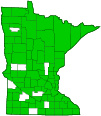Wood, mound, and field ants
(Formica spp.)
Overview • Description • Distribution • Taxonomy
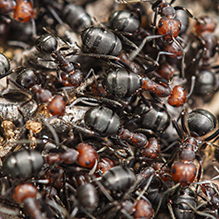
Overview
Formica is a large genus of ants known as wood, mound, and field ants. It is widespread, occurring throughout the northern hemisphere. There are 290 Formica species worldwide, 97 species in North America north of Mexico, and at least 36 species in Minnesota.
The genus Formica have been divided by taxonomists into seven to thirteen species groups based on distinctive features and behavior that can be easily seen in the field. The number of groups and the arrangement of species within those groups is a matter of debate. In 1950 Creighton recognized seven groups. Since then, some of those groups have been divided or renamed. Not all sources have adopted those changes.
Most Formica species live in open woodlands, forest openings, shrublands, or grasslands. Many build large mounds covered with thatch. Most are eusocial, the highest level of sociality. They cooperate to care for their offspring and the offspring of other individuals, there are multiple overlapping generations within a colony, and there is a division of labor into specialized castes.
A few Formica species are social parasites of one form or another. Some are temporary social parasites, where a queen invades a host colony and kills the queen. She then lays her own eggs and the host workers care for her young.
Some species are slave makers, where the queen invades a host colony, kills the host queen, and kills or drives off the host workers. The invading workers do not forage for food. Instead, they raid other colonies of the host species, capture host workers, and return them to the captured nest. The captured workers then do all the foraging for food and cleaning of the nest.
Some species are inquiline parasites, where the queen invades a nest but does not kill the host queen. She lays her own eggs, and the host workers tend to both their own and their invader’s young.
Description
Most Formica ants are large, more than ⅛″ (4 mm) in length.
On the worker, the antennae have twelve segments, on the male they have thirteen. They are inserted at or adjacent to the plate on the face (clypeus). The jaws (mandibles) have 7 to 10 prominent teeth. The simple eyes (ocelli) are large and conspicuous.
The front part of the body (mesosoma) has three exoskeletal plates on the upper side. The first plate (pronotum) and second plate (mesonotum) cover the thorax. Together they are referred to as the promesonotum. The third plate (propodeum) covers the first segment of the abdomen which is fused to the thorax. When viewed from the side, the propodeum is distinctly lower than the level of the promesonotum. This gives the mesosoma a distinctly “lumpy” appearance. The upper surface at the front of the propodeum is usually longer than the sloping surface at the rear. Sometimes it is evenly rounded, without a clear separation between the upper and rear surfaces.
The mesosoma and the rear part of the body (metasoma) are connected by a constricted second segment (petiole). There is a single raised bump (node) on the petiole.
Distribution |
||
|
Sources |
|
| 6/26/2025 | ||
Taxonomy
Order
Hymenoptera (Ants, Bees, Wasps, and Sawflies)
Suborder
Apocrita (Narrow-waisted Wasps, Ants, and Bees)
Infraorder
Aculeata (ants, bees, and stinging wasps)
Superfamily
Formicoidea (ants)
Family
Subfamily
Formicinae
Tribe
Formicini
Subordinate Taxa
cinerea-group wood ants (Formica cinerea group)
ant (Formica cinerea)
ant (Formica corsica)
ant (Formica fuscocinerea)
ant (Formica georgica)
ant (Formica selysi)
dakotensis-group wood ants (Formica dakotensis group) ![]()
![]()
bent-haired mound ant (Formica reflexa) ![]()
Dakota mound ant (Formica dakotensis) ![]()
exsecta-group wood ants (Formica exsecta group) ![]()
![]()
Allegheny mound ant (Formica exsectoides) ![]()
ant (Formica altayensis)
ant (Formica bruni)
ant (Formica fennica)
ant (Formica foreli)
ant (Formica forsslundi)
ant (Formica fukaii)
ant (Formica manchu)
ant (Formica mesasiatica)
ant (Formica pisarskii)
ant (Formica pressilabris)
ant (Formica suecica)
narrow-headed wood ant (Formica exsecta)
shaded-belly mound ant (Formica opaciventris)
Ulke’s mound ant (Formica ulkei) ![]()
fusca-group field ants (Formica fusca group) ![]()
![]()
ant (Formica albipennis)
ant (Formica browni)
ant (Formica candida)
ant (Formica cinerea)
ant (Formica cinereofusca)
ant (Formica clara)
ant (Formica cunicularia)
ant (Formica foreliana)
ant (Formica fuscocinerea)
ant (Formica gerardi)
ant (Formica glabridorsis)
ant (Formica glauca)
ant (Formica gnava)
ant (Formica hayashi)
ant (Formica kozlovi)
ant (Formica lemani)
ant (Formica lepida)
ant (Formica longipilosa)
ant (Formica microphthalma)
ant (Formica moki)
ant (Formica occulta)
ant (Formica pachucana)
ant (Formica propatula)
ant (Formica pulla)
ant (Formica retecta)
ant (Formica rufibarbis)
ant (Formica selysi)
ant (Formica sibylla)
ant (Formica subcyanea)
ant (Formica subelongata)
ant (Formica subpilosa)
ant (Formica yoshiokae)
black bog ant (Formica picea)
bright mound ant (Formica neoclara)
Canada mound ant (Formica canadensis)
dry mound ant (Formica xerophila)
Francoeur’s field ant (Formica francoeuri)
gray mound ant (Formica aerata)
Hewitt's mound ant (Formica hewitti)
high mound ant (Formica altipetens)
icy mound ant (Formica glacialis) ![]()
impolite mound ant (Formica subpolita)
Japanese wood ant (Formica japonica)
jet black mound ant (Formica gagatoides)
light bronze mound ant (Formica subaenescens) ![]()
New World red bearded field ant (Formica neorufibarbis) ![]()
overgrown mound ant (Formica accreta)
Pacific field ant (Formica pacifica)
podzol mound ant (Formica podzolica) ![]()
prairie mound ant (Formica montana) ![]()
silky ant (Formica fusca) ![]()
silvery field ant (Formica argentea) ![]()
somewhat silky mound ant (Formica subsericea) ![]()
transmountain mound ant (Formica transmontanis)
integra-group wood ants (Formica integra group) ![]()
![]()
agreeable mound ant (Formica propinqua)
ant (Formica calviceps)
ant (Formica coloradensis)
ant (Formica comata)
ant (Formica ferocula)
ant (Formica mucescens)
ant (Formica prociliata)
eastern mound ant (Formica integra)
flat-haired mound ant (Formica planipilis)
hairy mound ant (Formica ciliata)
horsehair mound ant (Formica criniventris)
Isabelline mound ant (Formica ravida)
northern red wood ant (Formica obscuriventris) ![]()
Oreo mound ant (Formica oreas)
pale-headed mound ant (Formica laeviceps)
pitted mound ant (Formica fossaceps) ![]()
shiny field ant (Formica subnitens)
vinegar ant (Formica integroides)
western thatching ant (Formica obscuripes) ![]()
microgyna-group field ants (Formica microgyna group) = difficilis-group field ants (Formica difficilis group) ![]()
Adams’s wood ant (Formica adamsi)
ant (Formica difficilis)
ant (Formica indianensis)
ant (Formica knighti)
ant (Formica morsei)
ant (Formica nevadensis)
ant (Formica postoculata)
ant (Formica scitula)
ant (Formica talbotae)
broadsword mound ant (Formica spatulata)
compact mound ant (Formica densiventris)
little mound ant (Formica nepticula)
piloerected mound ant (Formica querquetulana)
small mound ant (Formica microgyna)
unkempt flat mound ant (Formica impexa)
neogagates-group field ants (Formica neogagates group) ![]()
![]()
blunt-haired mound ant (Formica obtusopilosa) ![]()
bonded mound ant (Formica vinculans)
Bradley’s field ant (Formica bradleyi)
fuzzy mound ant (Formica lasioides) ![]()
Mann’s field ant (Formica manni)
New World mound ant (Formica neogagates) ![]()
Oregon field ant (Formica oregonensis)
sharp field ant (Formica limata)
very hairy mound ant (Formica perpilosa)
pallidefulva-group field ants (Formica pallidefulva group) ![]()
![]()
skull-collecting ant (Formica archboldi)
uncertain field ant (Formica incerta) ![]()
variable field ant (Formica pallidefulva) ![]()
Wilson’s field ant (Formica biophilica)
wily field ant (Formica dolosa) ![]()
rufa-group wood ants (Formica rufa group) ![]()
ant (Formica dusmeti)
ant (Formica frontalis)
ant (Formica helvetica)
ant (Formica kupyanskayae)
ant (Formica paralugubris)
ant (Formica polyctena)
ant (Formica sinensis)
ant (Formica truncorum)
ant (Formica ussuriensis)
black-backed meadow ant (Formica pratensis)
hairy wood ant (Formica lugubris) ![]()
Scottish wood ant (Formica aquilonia)
southern wood ant (Formica rufa) ![]()
rufabarbis-group wood ants (Formica rufabarbis group)
ant (Formica anatolica)
ant (Formica clara)
ant (Formica cunicularia)
ant (Formica glabridorsis)
ant (Formica orangea)
ant (Formica persica)
ant (Formica tarimica)
ant (Formica tianshanica)
red-barbed ant (Formica rufibarbis)
slave-raider field ants (Formica sanguinea group) ![]()
![]()
ant (Formica creightoni)
blood-red field ant (Formica sanguinea)
curious mound ant (Formica curiosa)
downy ant (Formica puberula)
Emery’s mound ant (Formica emeryi)
obligate slave-making mound ant (Formica subintegra)
Pergandi’s mound ant (Formica pergandei)
ruddy slave-making mound ant (Formica rubicunda)
slave-making mound ant (Formica aserva) ![]()
Wheeler’s field ant (Formica wheeleri)
wickerwork mound ant (Formica gynocrates)
subpilosa-group wood ants (Formica subpilosa group)
ant (Formica clarissima)
ant (Formica kashmirica)
ant (Formica litoralis)
ant (Formica pamirica)
ant (Formica subpilosa)
Synonyms
Adformica
Coptoformica
Formicina
Neoformica
Raptiformica
Serviformica
Common Names
wood ants, mound ants, and field ants
wood, mound, and field ants
Glossary
Clypeus
On insects, a hardened plate on the face above the upper lip (labrum).
Mesonotum
The principal exoskeletal plate on the upper (dorsal) part of the middle segment of the thorax of an insect.
Mesosoma
In Hymenoptera: the front part of the body, consisting of all three segments of the thorax and the first segment of the abdomen, to which the wings are attached.
Metasoma
In Hymenoptera: the armored rear part of the body, consisting of the second segment of the abdomen and all segments posterior to it.
Petiole
On plants: The stalk of a leaf blade or a compound leaf that attaches it to the stem. On ants and wasps: The constricted first one or two segments of the rear part of the body.
Ocellus
Simple eye; an eye with a single lens. Plural: ocelli.
Pronotum
The exoskeletal plate on the upper side of the first segment of the thorax of an insect.
Propodeum
In Hymenoptera: the last segment of the thorax, anatomically the first segment of the abdomen.
Visitor Photos
Share your photo of this insect.
This button not working for you?
Simply email us at info@MinnesotaSeasons.com.
Attach one or more photos and, if you like, a caption.
Dan W. Andree |
||
 |
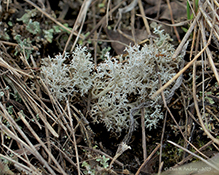 |
|
Ant on Reindeer Lichen... This ant crawled in and through areas of this small reindeer lichen then eventually just exited off. |
||
| 2 Ants & a Lady bug... | ||
Bill Reynolds |
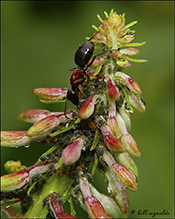 |
The ant is tending to aphids on Fireweed. |
MinnesotaSeasons.com Photos
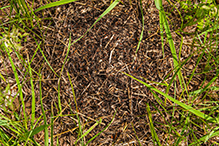 |
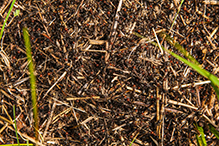 |
|
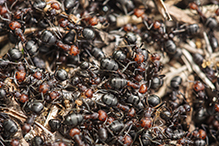 |
 |

Slideshows

Visitor Videos
Share your video of this insect.
This button not working for you?
Simply email us at info@MinnesotaSeasons.com.
Attach a video, a YouTube link, or a cloud storage link.
Other Videos

Visitor Sightings
Report a sighting of this insect.
This button not working for you?
Simply email us at info@MinnesotaSeasons.com.
Be sure to include a location.
Dan W. Andree
11/13/2025
MinnesotaSeasons.com Sightings

